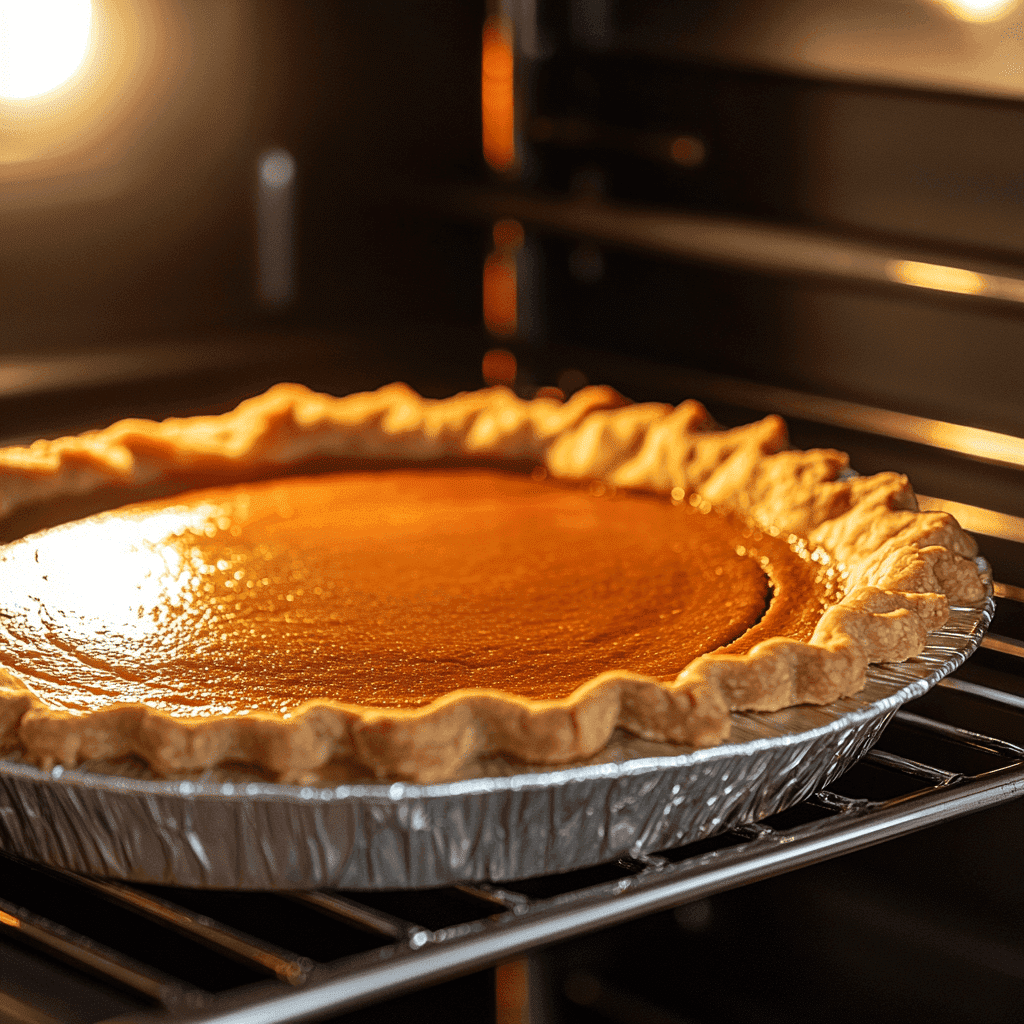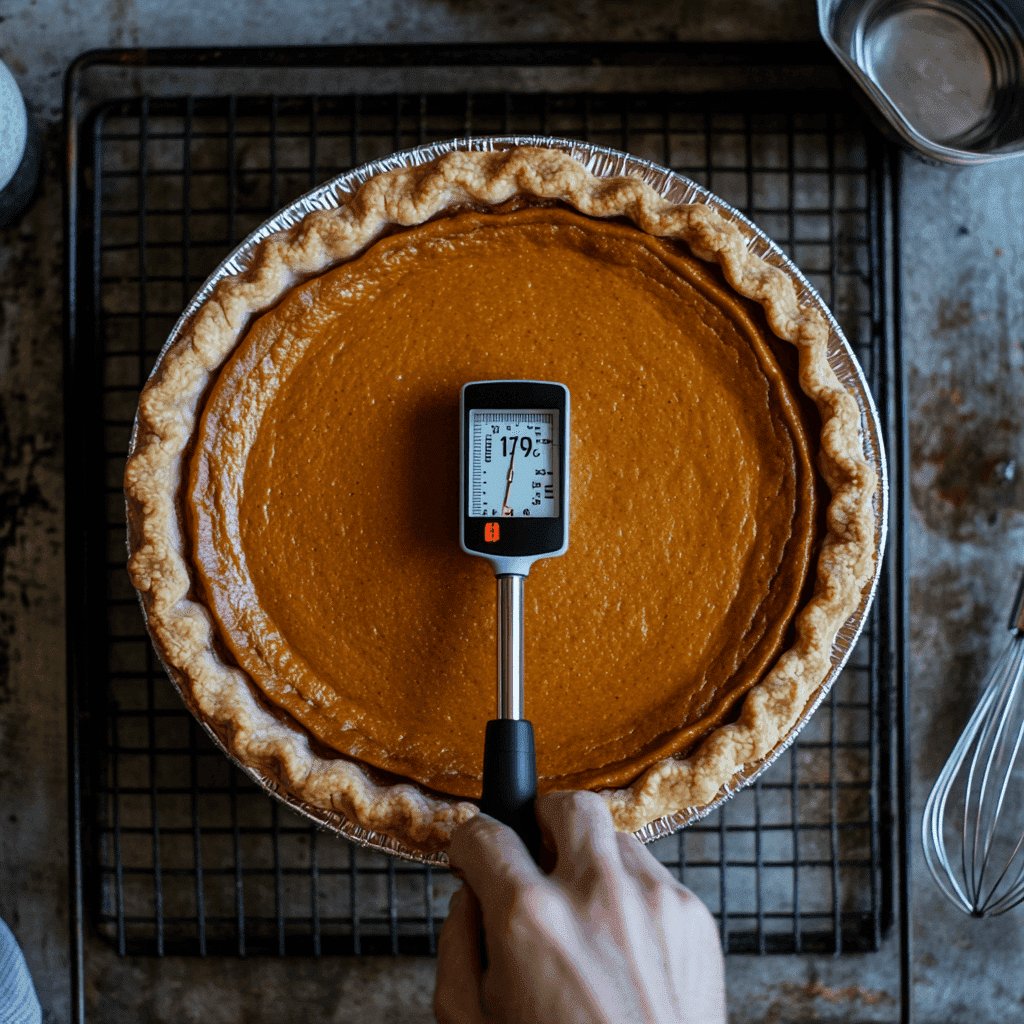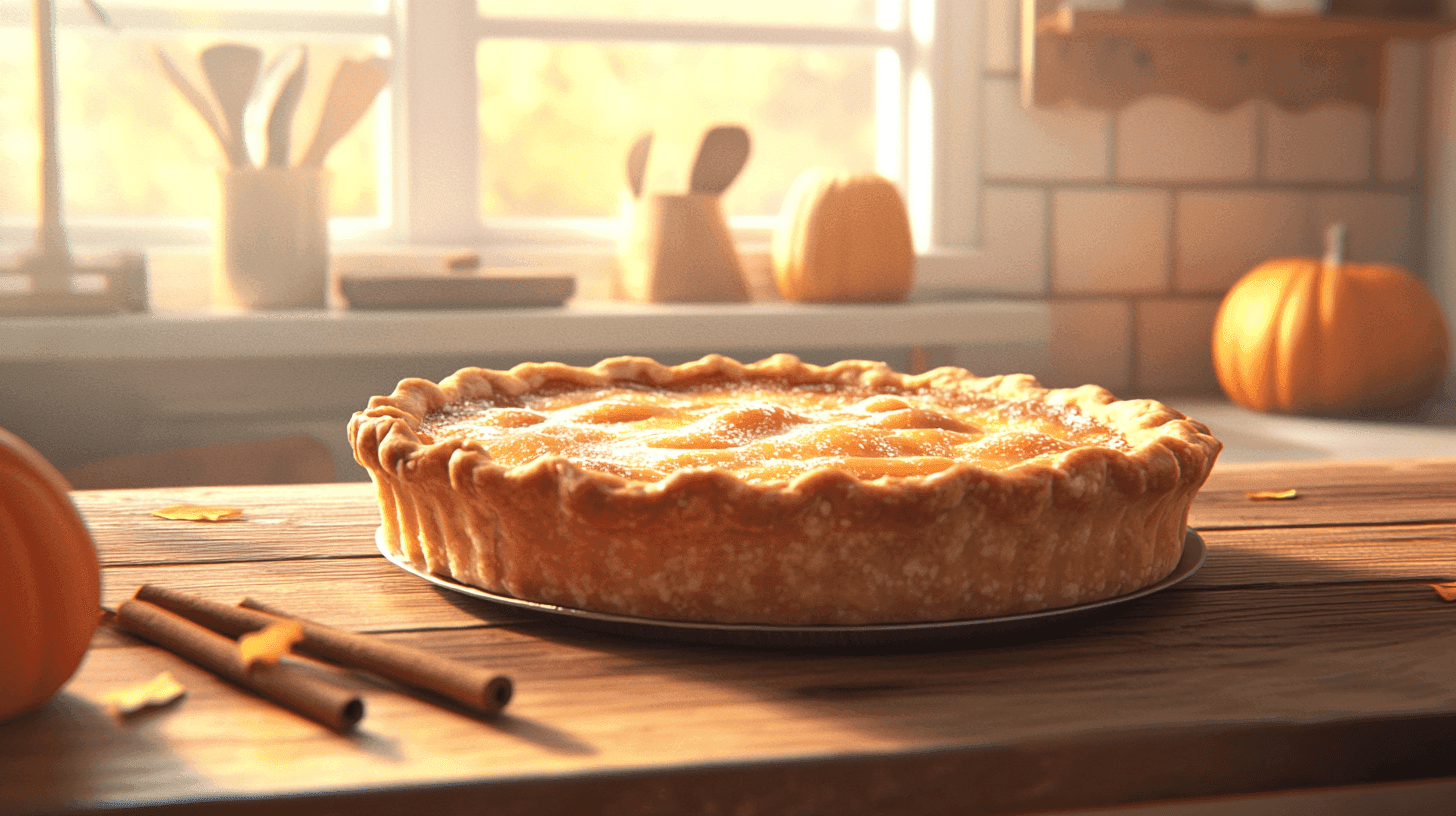How can I tell when the pumpkin pie is done?”—it’s a question every home baker has pondered at least once. We’ve all been there: eagerly watching the oven, wondering if the pie is ready or if it needs just a few more minutes. Don’t worry, you’re not alone! Pumpkin pie is a beloved dessert, and knowing exactly when it’s perfectly baked can feel like a mystery. First, let’s talk about the joy of making this seasonal favorite. It’s simple, comforting, and packed with rich, wholesome ingredients that make every bite worth savoring.
But here’s the secret: baking the perfect pumpkin pie isn’t just about following the recipe—it’s about recognizing the telltale signs that it’s ready to come out of the oven. From its silky filling to the flaky crust, this pie is a showstopper for any occasion. Ready to crack the code and bake a pie that’s deliciously golden and just right? Keep reading to uncover all the tips and tricks for success. You’ve got this!
Table of contents
Signs Your Pumpkin Pie Is Fully Cooked
Checking for a Slight Jiggle in the Center

One of the simplest ways to know if your pumpkin pie is done is to check for a slight jiggle in the center. This trick is like a fun little dance for your pie! First, gently shake the pie pan while it’s still in the oven. If the edges are set, but the center wobbles slightly, your pie is ready to come out. The jiggle should remind you of gelatin, firm but with a bit of movement. Be careful not to mistake a liquidy wobble for doneness—it’s a subtle difference. Also, don’t worry about perfection; the pie will continue to firm up as it cools. This method ensures that the filling remains creamy without overbaking. If you’ve ever wondered, “How can I tell when the pumpkin pie is done?” this easy tip is your answer. Try it, and you’ll feel like a baking pro in no time!
The Toothpick or Knife Test for Doneness
Another classic way to test if your pumpkin pie is done is the toothpick or knife method. It’s a trusty old-school trick that works like magic. Simply insert a toothpick or thin knife into the center of the pie. If it comes out clean or with just a few crumbs, you’re all set! However, if the toothpick is coated with filling, the pie needs more time. This method is especially handy for those who prefer a little extra reassurance. Remember, though, to poke gently so you don’t disturb the beautiful pie top too much. In addition, the filling will set as it cools, so don’t wait for it to look completely dry. If you’re asking yourself, “How can I tell when the pumpkin pie is done?” this test is a foolproof answer. Plus, it’s oddly satisfying to see the clean result!
Temperature Tips for Perfectly Baked Pumpkin Pie

Using a Food Thermometer to Check Readiness
A food thermometer is your best friend when baking pumpkin pie to perfection. It takes all the guesswork out of the process. First, grab your kitchen thermometer and insert it into the center of the pie. Make sure it doesn’t touch the bottom of the pan, as that can give a false reading. You’re aiming for an internal temperature of 175°F, which ensures the filling is fully cooked without being overdone. Also, don’t worry if the edges look slightly darker—that’s totally normal. Using this method means you’ll never have to wonder, “How can I tell when the pumpkin pie is done?” again. It’s precise, reliable, and perfect for beginners or anyone who loves foolproof baking. Plus, isn’t it fun to feel like a scientist in the kitchen?
Ideal Internal Temperature for Pumpkin Pie
Knowing the ideal internal temperature is key to baking the perfect pumpkin pie. When the thermometer reads 175°F, you can be confident that your pie is just right. The filling will be smooth and creamy without being runny or overly firm. If you bake beyond this temperature, the filling may crack or dry out, which nobody wants! In addition, remember to check the temperature toward the end of the baking time, so you don’t overdo it. This method is easy and gives you consistent results every time. If the question, “How can I tell when the pumpkin pie is done?” has been on your mind, this tip will save the day. Trust the thermometer, and you’ll have a dessert that looks as good as it tastes.
Visual Cues That Your Pumpkin Pie Is Ready
Crust Color and Texture as Indicators
Your pumpkin pie crust is a great visual clue for determining doneness. When the edges are golden brown and slightly puffed, it’s a good sign the pie is nearly ready. Pay attention to the texture, too; the crust should look firm and flaky. First, check for an even color all around the pie. Next, ensure there are no overly dark spots, as this could mean overbaking. If the crust looks pale, the pie likely needs more time. This simple observation will help you feel confident in your baking skills. And if you’ve ever wondered, “How can I tell when the pumpkin pie is done?” let the crust guide you. It’s like your pie’s way of saying, “I’m ready to be enjoyed!”
Avoiding Overbaking Through Surface Observations
Overbaking can be the downfall of a delicious pumpkin pie, but surface clues can help you avoid this mistake. Look for a slightly puffed filling around the edges, with a matte finish in the center. If the top begins to crack, the pie may have baked a bit too long. Also, keep an eye on the color—it should be a rich, warm orange, not overly dark. These small details make a big difference in the final texture and taste. Observing these signs is a fun and stress-free way to answer the question, “How can I tell when the pumpkin pie is done?” Plus, it’s a great excuse to spend more time admiring your delicious creation.
Common Baking Mistakes to Avoid
Understanding the Effects of Overbaking
Overbaking your pumpkin pie can lead to a dry, cracked filling, which nobody wants! The filling should remain smooth and creamy, not rubbery. First, keep an eye on the time and use visual and temperature cues to avoid overdoing it. Next, remember that the pie continues to cook slightly as it cools. If you leave it in the oven too long, the texture may suffer. This is why knowing the answer to “How can I tell when the pumpkin pie is done?” is so important. By learning what to watch for, you’ll bake with more confidence and avoid common mishaps.
How to Prevent Undercooked Filling
An undercooked pumpkin pie is just as disappointing as an overbaked one. To prevent this, always check for doneness using multiple methods, like the jiggle test or a thermometer. Also, be patient and avoid cutting the pie too soon. The filling sets as it cools, so giving it time is crucial. These simple steps ensure your pie will always turn out just right. If you’ve ever been frustrated by underbaking, this advice is your key to success.
Learn how to make a pie crust from scratch and impress your family and friends with a homemade touch. Alternatively, if you love pumpkin-based desserts, why not explore this pumpkin olive oil cake recipe for your next treat?
Alternative Methods for Judging Pie Doneness
Press Test: Gently Checking the Surface
The press test is a hands-on way to check if your pumpkin pie is done. Gently press the center of the pie with your fingertip or the back of a spoon. If it feels firm but has a slight give, your pie is ready. This method is easy, fun, and surprisingly effective. It’s another answer to the classic question, “How can I tell when the pumpkin pie is done?” Plus, it makes you feel more connected to your baking process, like a true kitchen pro.
Using Smell to Determine Baking Progress
Your nose can be a great guide when baking pumpkin pie. As the pie nears doneness, you’ll notice a warm, spicy aroma filling your kitchen. This is a natural indicator that the ingredients are baking to perfection. If you’ve been wondering, “How can I tell when the pumpkin pie is done?” trust your senses. Smelling the deliciousness is half the fun!
Frequently Asked Questions (FAQs)
How to tell if a pumpkin pie is cooked?
To know if your pumpkin pie is cooked, look for a slight jiggle in the center. This wobble should be subtle, not liquidy. Also, check that the edges are firm and slightly puffed. A food thermometer is another foolproof option—aim for 175°F in the center. In addition, the crust should appear golden and firm, not pale or underbaked. Using these methods ensures a pie that’s creamy and delicious. Wondering, “How can I tell when the pumpkin pie is done?” These tips will make it easy. With a little practice, you’ll nail it every time!
Should pumpkin pie still be jiggly in the middle?
Yes, the middle of a pumpkin pie should still jiggle slightly when it’s done. This jiggle means the filling will set perfectly as it cools. First, check for edges that are firm but not cracked. Next, gently shake the pie pan to observe the center. If the wobble is too liquidy, it needs more time. This step helps avoid overbaking, which can dry out the filling. Remember, pumpkin pie continues to cook slightly after it’s out of the oven. This method makes answering, “How can I tell when the pumpkin pie is done?” simple and stress-free!
How do you know when pumpkin is done cooking?
Knowing when pumpkin is done cooking depends on the method. For a pie, the filling should jiggle slightly in the middle. If you’re roasting pumpkin, it’s done when it’s fork-tender and easy to mash. A food thermometer is handy for pies—175°F in the center is ideal. Also, watch for visual cues like a golden crust or caramelized edges in roasted pumpkin. These tips take the guesswork out of cooking. If you’re wondering, “How can I tell when the pumpkin pie is done?” or any pumpkin dish, these steps will help you every time.
How can you tell if a pie pumpkin is still good?
To check if a pie pumpkin is still good, start with its appearance. A fresh pumpkin should have smooth, firm skin without soft spots or mold. Next, tap it gently—if it sounds hollow, that’s a good sign. Also, check the stem; it should feel dry but still attached. A pumpkin that feels too light for its size may be drying out inside. Smell it, too—a fresh pumpkin will have a neutral, earthy aroma. With these simple checks, you’ll never have to wonder if your pie pumpkin is ready for baking!
Mastering the Art of Knowing When Pumpkin Pie Is Done
Congratulations—you’re now ready to bake a perfect pumpkin pie with confidence! Learning how to tell when the pumpkin pie is done is like unlocking a little baking superpower. First, remember to trust the visual and texture clues, like a golden crust and a slightly jiggly center. Then, use tools like a thermometer or a toothpick for extra reassurance. Also, keep in mind that pies continue to set as they cool, so don’t overbake. With these tips, you’ll never have to second-guess yourself in the kitchen again. Baking can feel like a fun little adventure, and each pie is a new triumph. Whether it’s for a holiday or just because you’re craving something sweet, your pumpkin pie will shine every time. So, roll up your sleeves, enjoy the process, and savor the delicious results. You’ve got this, and your pie will be as amazing as you are!

